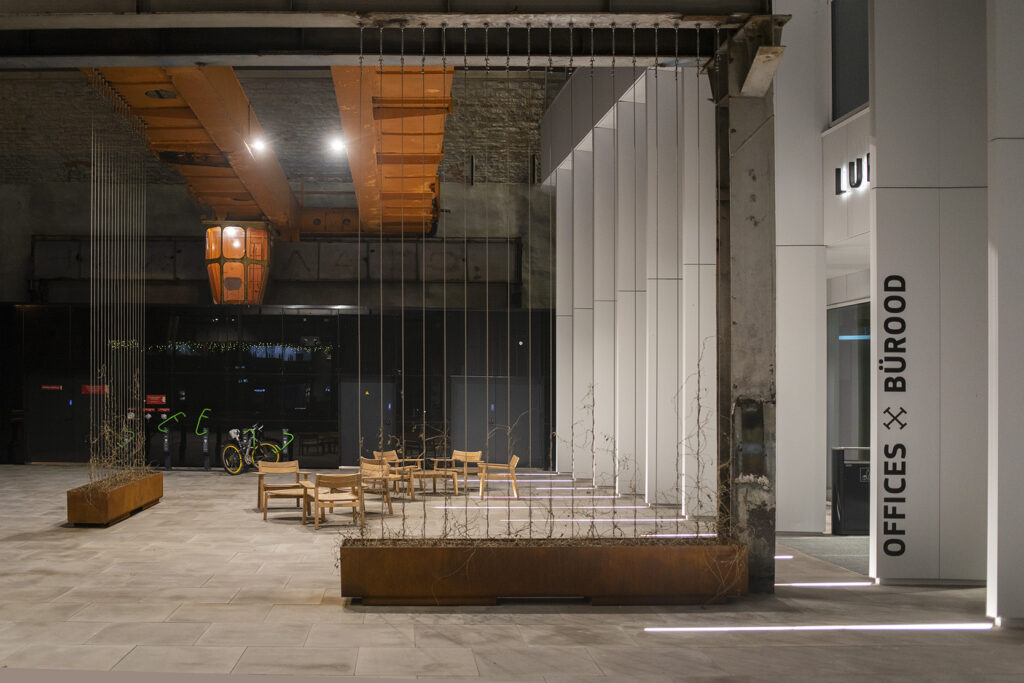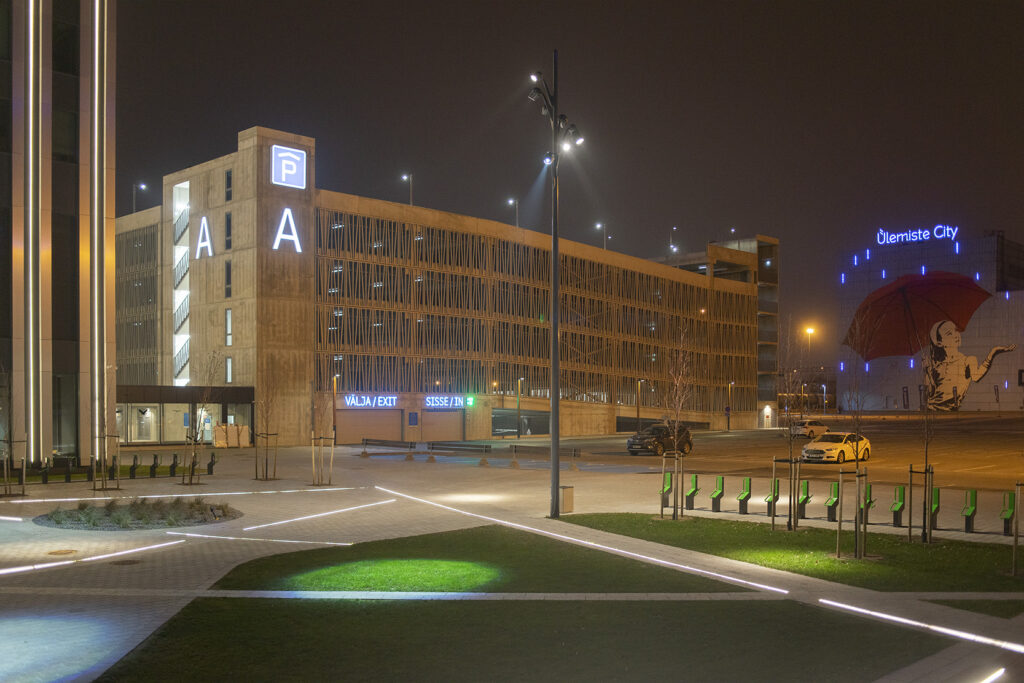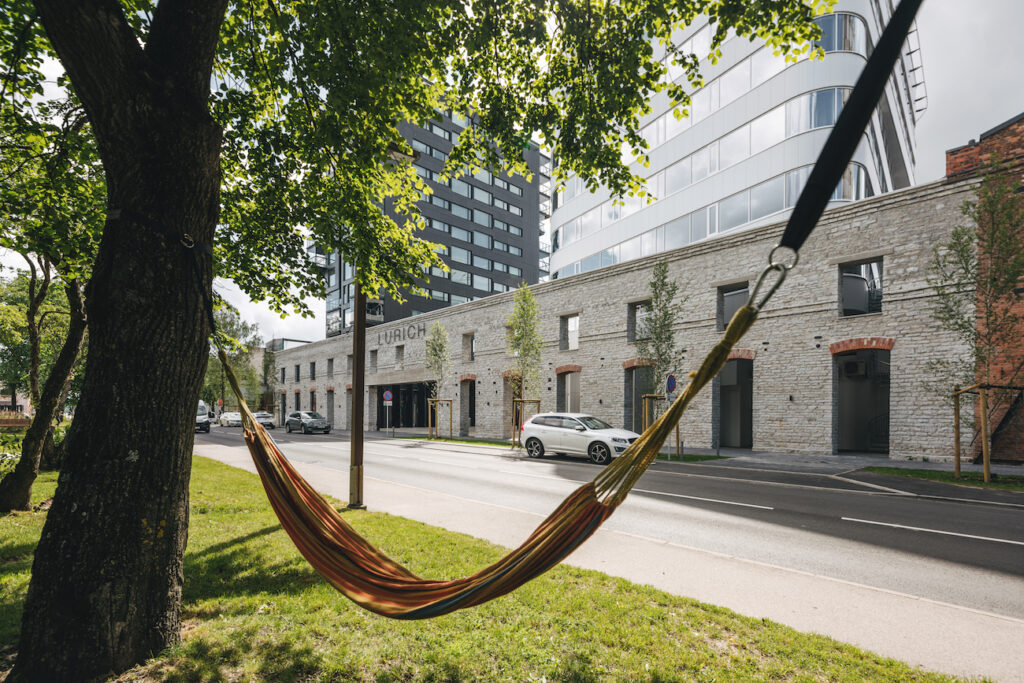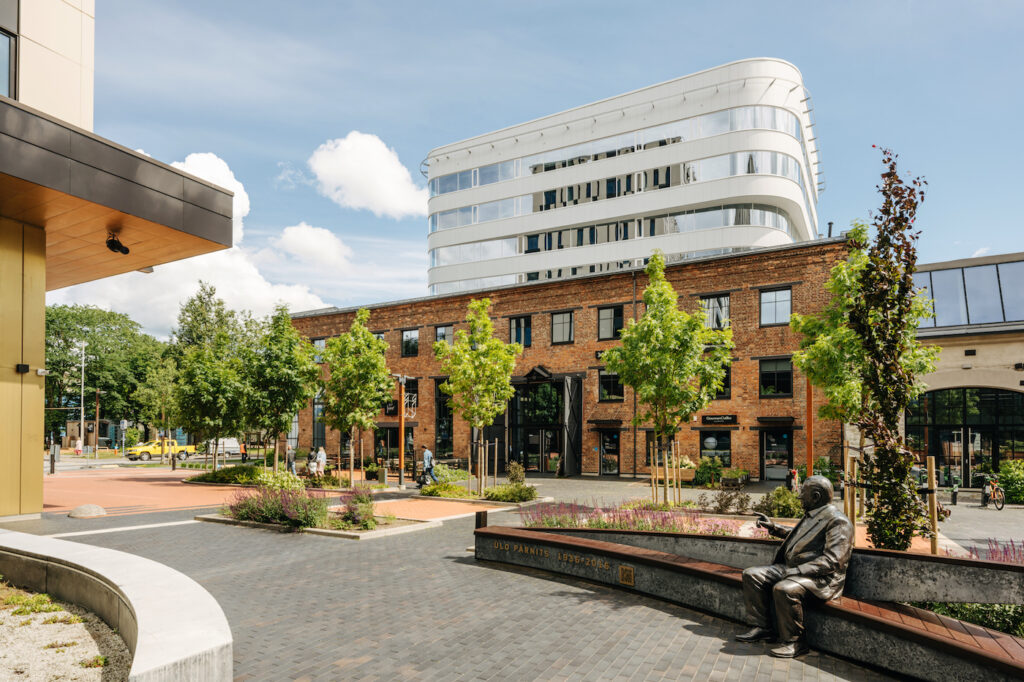Ülemiste City presents itself as a compass for the future and the first smart work and living environment in Estonia. The contemporary approach to smart living environments focuses on the needs of the people. We will explore to what extent Ülemiste district meets people’s environmental psychological needs.
Smart city
Over the last decade, few urban development models have been as popular as the smart city. The advances in technology have made this once utopian idea more attainable than ever. As of 2020, 75% of the European population is urbanized with nearly 70% in Estonia1. Smart city infrastructures have emerged as a possible solution to sustainability problems deriving from rapid urbanization. Insights based on data collected from ICT and IoT networks are used to optimize the dynamics of the city. It is thought that by having the right information at the right time, citizens, service providers and local governments will be able to make better decisions that result in increased quality of life for urban residents and the overall sustainability of cities.
Smart cities are said to be people-oriented2. In addition to sustainability, smart solutions should also focus on the residents’ health, security and well-being. However, various terms such as ‘smart’, ‘intelligent’, ‘wired’, ‘cyber’, ‘informational’, ‘sentient’ or ‘cognitive’ are used loosely. The entire concept of the smart city is considered too vague3. Countless metrics and benchmarks are available to evaluate how ‘smart’ a city is. Therefore, it is hard to comprehend what it means to become a ‘smart’ city in the first place. With some two dozen different and controversial definitions, it is no wonder that smart cities still struggle to create liveable living environments.
Studies point to a narrow strategic focus in urban development policies5. Infrastructural improvements have so far been higher on the list of priorities of political leaders in Central and Eastern Europe than more sophisticated digital, circular economy or other smart solutions, indicating low awareness of the emerging urban sustainability challenges on the local government level in the EU. The multidisciplinary concept of sustainability is generally addressed through the tripartite model of environment, economy, and society6. Unfortunately, it has been more challenging to find a definition for social sustainability than to economic and environmental sustainability. Social sustainability occurs when current and future generations are able to create and maintain healthy and liveable communities and neighbourhoods that promote well-being. However, the emphasis in the wider debate has been on environmental and economic concerns leaving the social aspects largely neglected.

The absent psychological perspective
Smart city models seem to have neglected one of the most important elements of health and well-being—the human psyche. In their latest book Psychology & the City: The Hidden Dimension, urbanist Charles Landry and scientist Chris Murray argue that urban decision makers have not been taking psychology seriously enough7. They urge specialists and public officials to see the urban fabric, its dynamics and processes through the psychological lens when developing and establishing new urban policies.
On 27 June 2019, Europe’s first Urban Psychology Summit ‘City, Psychology, Place’ was hosted in London8. The main focus was on the links between urban policies and mental health, experience of place shaping individuals and communities, the contribution of neuroscience to urban development, and strategies for urban mental health. It was concluded that people and place should be considered as one united construct, the evidence and tools should be made available and useable for specialists, and more research into urban issues and solutions should be conducted from a psychological perspective.
In 1971, Danish environmental and behavioural psychologist Ingrid Gehl wrote the book Bo-Miljø standing for living environment. Issued in the publication series of the Danish Building Research Institute, the book provides social sustainability mechanisms with various principles from environmental psychology. In his article ‘Social Sustainability in Context: Rediscovering Ingrid Gehl’s Bo-Miljø’ from 2016, Terri Peters argues that instead of drawing up an environmental checklist for designers, Gehl highlighted people’s various psychological needs that designers of the environment should address creatively. Gehl relied on studies in environmental psychology, psychology, sociology and geography to describe how people experience public and semi-public urban space. She identified eight environmental psychological needs that should be considered in the creation of living environments. These are (1) the need for human contact; (2) the need for privacy; (3) the need for varied experiences; (4) the need for purposefulness; (5) the need for play; (6) the need for structure and orientation within the environment; (7) the need for a sense of ownership and identification with the community and environment; and (8) the need for aesthetics and beauty.
The basis of Gehl’s ideas has been considered in greater detail in various branches of psychology such as the self-determination theory9, the attention restoration theory10, the concepts of place attachment11 and place identity12. However, her ideas have found little reflection in scientific literature, including her husband Jan Gehl’s publications. In the light of the topics of environmental psychology, Ingrid Gehl’s eight principles provide a promising premise. The principles of bo-miljø came to be explored again only in 2016 in Terri Peters’ article on social cohesion and sustainability. On their website, Ülemiste City is advertised as a place bringing together an incredible community, fresh ideas and sustainable mindset. Have the principles of bo-miljø been implemented in Ülemiste City? If so, how is it expressed and how could the principles be explored in other contexts? Gehl’s book deals with relatively universal human needs that can be implemented in the creation of various environments at large.

Human contact
Research has shown strong relations between social ties and health13. Having social contact activates neural regions that process safety signals and inhibit the ones dealing with stress. So, facilitating human connection through place is crucial. People cannot be forced to form deep and meaningful connections with each other. As suggested by self-determination theory, motivation is mediated through autonomy. We are driven to connect with others when we have freedom to choose where, when, how and with whom we communicate. The public space in Ülemiste City offers some ways to facilitate social relations, for instance, green areas with moveable urban furniture. In order to ensure comfort, the environment can be changed according to preferences. Public table tennis and smoking booths are the amenities that could further enhance sociality but that’s about it.
Research has also shown that exposure to the natural environment can increase attention to others, facilitate collective engagement and enhance prosociality—tendencies to care for and help others14. We know that nature has a beneficial effect on people’s health such as lowering stress, blood pressure and hypertension, similarly reducing the risk of asthma, stroke and heart disease. But nature also helps to change one’s perspective and see the world from a different point of view. This happens when one experiences beauty and awe. Awe can arise from various stimuli including powerful architecture but mostly in encounters with nature such as sunsets, mountain ranges and scenic views. Ülemiste City offers a little both views of urban nature and architectural landmarks such as the old water tower or other old and massive buildings.
Also place attachment, the emotional bond between an individual and their meaningful environment forms partly due to site-specific social relations. People with high place attachment tend to care more for the places they are attached to. Thus, physical environments can be used to foster more resilient communities who, in turn, will further contribute to the place. Whether joint events organised by the leaders or civic engagement on the grass-root level, place attachment increases when the activities are supported by the environment.

Privacy
With human contact comes the need for privacy. In consideration of the basic psychological needs theory, the need for social privacy is satisfied when we are free to choose the intensity, amount and duration of our human contacts. Choice, regulation and control over socialization are critical. Privacy supports normal psychological functioning, stable interpersonal relationships and personal development15. When privacy is disturbed, stress occurs, impulsivity increases and sense of competence declines. In Ülemiste City, there is plenty of open public space, so finding one’s own spot is easy. The streetscape with urban green areas forms a grid that is conveniently walkable. There are few territorial boundaries that would limit the options for wandering. In the light of social sustainability, privacy is as important as contact enabling emotional and mental self-regulation and recuperation.
While privacy allows to manage one’s inner imbalances and struggles, so does visiting one’s favourite place. Research in place attachment has shown that people’s favourite places tend to be restorative16. People visit places they are attached to in times of crisis and hardships to find solace and refuge. Restorative places are environments that are fascinating, coherent, allow to escape the daily routine and align with the person’s intentions. Ülemiste City is made fascinating by its historic layering. The uniform feel of the landscaping makes the scene look more coherent. Various options to move around the area and manipulate the environment with street furniture support the freedom to carry out people’s intentions. Large murals on the walls captivate our imagination and allow us to forget our daily worries. Mental restoration hand in hand with privacy benefit and amplify each other’s positive features.
Varied experiences
Ingrid Gehl considered an environment varied when spatial design has made use of nature as well as temporary and seasonal solutions such as sunshades, picnic tables or ice rinks, when buildings are of various size and mixed use and the urban space can be moved around in different ways. The given aspects are also explained by the attention restoration theory and the self-determination theory. The former proposes that mental restoration can occur in a rich environment providing a sense of discovery. The surroundings do not need to be large in dimensions but capable of holding a person’s attention. Then again, the environment must not exhaust attention either. It thus requires a particular spatial consistency that does not allow the environment to become either too monotonous or too hectic. In Ülemiste City, the historical industrial architecture serves the function of spatial consistency by providing a more uniform background in the urban scene. The examples here are the limestone buildings and water tower in Keevise Street or the hoist in the courtyard of Lurich building.
One of the premises of the self-determination theory is the freedom of choice along with individual preferences. In case there are options of various intensity, content and complexity to use and to move or stay in the public space, everyone can select their preferred way to relate to the environment. The hammocks near ÖÖD mirror houses provide a more comfortable and intimate alternative to park benches. The Bikeep bicycle shelters in Sepise Street allow cyclists to maintain and fix their bikes themselves in open air.
Purposefulness
Gehl considered purposefulness a psychological need as people want to have meaningful possibilities for self-actualisation and to contribute to the community. The self-determination theory likewise proposes that people have a basic psychological need for relatedness—an attachment to an external goal, a vision shared with a community. Satisfying the need for relatedness forms the basis for general well-being and inner motivation. According to self-determination theory, a person can achieve self-actualisation through common goals only if it is his or her free choice. The person must have the freedom to choose where to contribute in order to feel like a necessary member of the community. Gehl suggested that architecture could provide possibilities for participating in volunteer work and contributing to the community, for instance, by means of community gardens and interest group activities. There are currently no community gardens in Ülemiste City, although some of the rooftops have been taken into use as community hangout areas.

Play
According to Gehl, play should take place in a versatile and inspiring environment while involving our various senses and entire motor activity. Play is not restricted to children and it is also meant for adults. Play provides possibilities for various kind of behaviour as well as the freedom to experiment. Similarly to the self-determination theory by Ryan and Deci, also Gehl suggested that play is related to well-being, satisfaction and happiness. For instance, the steps on the Flag Square allow the users to interact with the space in various ways or the boardwalk around the pond in Ülemiste City Park that offers an interesting change to the traditional solid street pavement.
However, apart from table tennis and bike mending, there is not much else to do in the urban space. In the light of the given solutions, the campus comes across as somewhat sterile and over-planned for stimulating play. A good play, according to self-determination theory, poses sufficient challenge, common goals and opportunities for experimentation. Then again, people understand challenge differently. Thus, also the urban space should be flexible. Active engagement, one of the five basic needs in a public space, proposes that people want common activities, face-to-face communication and contribution, joy from the interaction and reassurance that they are members of the community17. Such free and playful areas allowing the users to relate to the environment and other people in their own way tend to be scarce.
Structure and orientation
Gehl considered the need for structure and organisation in the living environment highly important. According to her, it is important that the environment indicates where people are at the moment. She highlighted the importance of visual signs and spatial orientation in the space. The environment must entail the option to create mental landmarks allowing the users to position themselves in relation to the surroundings. An environment characteristic of a particular site must therefore have distinctive features. Then again, in terms of attention it is important to keep the informational noise low. As attention is a limited resource that is easily exhausted, there should not be too many competing stimuli in the environment. This may happen as a result of rapid changes in the environment. Our nervous system is designed to respond to changes. In a rapidly changing environment, our body must be able to assess the safety of the situation and adapt, if necessary, by mobilising the body’s resources. This, however, is taxing, especially in case of competing stimuli when one needs to deal with various things simultaneously. The common problem for urban environments, for instance, is technostress with no sufficient possibilities for restoration. In the light of the attention restoration theory, such relevant ‘means’ for orienting in space should be clearly recognizablein the environment. Ülemiste City has its own direction sign system with its distinctive design standing out from the visual noise and traffic signs. This, in turn, facilitates orientation and distinguishing relevant information from the irrelevant background.

Ownership and identification
Bo-miljø stresses that the possibility of personalising and influencing space leads to a sense of ownership and identification with the environment. The given idea is strongly rooted in the Danish spatial design and rental market principles in order to increase resident satisfaction and support their well-being18. Today, these ideas have evolved, for instance, into inclusive planning principles. Similar approaches could be used also for growing a strong and sustainable community by actually involving them in the activities and considering their input in decision-making.
A sense of ownership is also accompanied by people’s care for the surrounding space and their wish to contribute to its development. These stand for the features of place attachment that could be used for measuring the strength of the community. The given processes also generate the place identity guiding our attitudes, thoughts and feelings regarding a place. By identifying with a place, we process information and relate to the world through its filters. There tends to be few signs of place attachment and place identity in the public space of Ülemiste City. The current environment does not provide many possibilities for influencing and changing the space and there are very few individual traces of human activity. The environment looks exactly as it was designed and not what it could have turned into as a result of community activities.
Aesthetics and beauty
They say that beauty is in the eye of the beholder. In the psyche of the beholder, to be exact. For centuries, aesthetics has been ascribed numerous different mechanisms and explanations. Also Gehl considered beauty and aesthetics as important needs, highlighting order, variety and harmony. Gehl stressed that beauty must be available through various senses. Unfortunately, studies of aesthetics have no clear-cut answers as to what an aesthetic experience is19. Although neuroaesthetics is still a relatively new field, some neural correlates of an aesthetic experience have been discovered. In other words, it is in general terms known what is going on in the brain during an aesthetic experience but there is no scientific consensus as to why it is so. At present, it is known that an aesthetic experience activates the sensorimotor areas in the brain, similarly the areas related to processing emotions and reward20. Whether Ülemiste City is beautiful and aesthetic remains to be judged by the beholder until neuroaesthetics provides us with better answers.
Conclusion
As long as smart cities continue their triumph, it would be reasonable to think also about the third branch of sustainability—social sustainability. If we want a people-centered urban space, we need to include people with their psycho-physiological features and diversity in these discussions and analyses. The closer science gets to describing human experience, the better our possibilities to integrate the knowledge into the smart city mass data flows and to make decisions in spatial design and spatial policies that are truly oriented to people. Ingrid Gehl has proposed one way to describe person and environment as an integrated whole. But there are more such ways in environmental psychology ….

SILVER STERNFELDT is an environmental psychologist developing the field of evidence-based design. He has led various projects of people-oriented space in cooperation with public organisations and also worked as a lecturer and supervisor at the Estonian Academy of Arts and Tallinn University of Technology. Silver is also the founder of Keskkonnapsühholoogia Uuringud OÜ.
HEADER: Ülemiste City. Photo: Paco Ulman
PUBLISHED: Maja 103 (winter 2021) Smart Living Environment
1 „Degree of urbanization by continent in 2020,“ Statista, accessed December 4, 2020, https://www.statista.com/statistics/270860/urbanization-by-continent/
2 Nasrin Khansari, Ali Mostashari, Mo Mansouri, „Impacting sustainable behavior and planning in smart city,“ International journal of sustainable land Use and Urban planning 1, no. 2 (2014).
3 Tooran Alizadeh, Jathan Sadowski, „Smart urbanism: processes, practices, and parameters,“ Telematics and Informatics (2020): 101493.
4 Angeliki Maria Toli, and Niamh Murtagh, „The concept of sustainability in smart city definitions,“ Frontiers in Built Environment 6, (2020): 77.
5 Marcello Cabria, Annick Magnier, Patricia Pereira, „Mayors’ agendas: emerging variations on the theme of entrepreneurialism.” In Political Leaders and Changing Local Democracy, “ Palgrave Macmillan, Cham, 2018), 243–272.
6 Terri Peters, „Social sustainability in context: rediscovering Ingrid Gehl’s Bo-miljø,“ arq: Architectural Research Quarterly 20, no. 4 (2016): 371–380.
7 Charles Landry, Chris Murray, Psychology & the City: The Hidden Dimension (Comedia, 2017).
8 City, Psychology, Place: An Urban Psychology Summit, University of Liverpool, accessed December 4, 2020, https://www.liverpool.ac.uk/heseltine-institute/events/citypsychologyplaceanurbanpsychologysummit/
9 Richard M. Ryan, Edward L. Deci, „Self-determination theory and the facilitation of intrinsic motivation, social development, and well-being,“American psychologist 55, no. 1 (2000): 68.
10 Stephen Kaplan, „The restorative benefits of nature: Toward an integrative framework,“ Journal of environmental psychology 15, no. 3 (1995): 169–182.
11 Leila Scannell, Robert Gifford, „Defining place attachment: A tripartite organizing framework,“ Journal of environmental psychology 30, no. 1 (2010): 1–10.
12 Patrick Devine-Wright, Susan Clayton, „Introduction to the special issue: Place, identity and environmental behaviour,“ Journal of environmental psychology 30, no. 3 (2010): 267–270.
13 Naomi I. Eisenberger, „Social ties and health: a social neuroscience perspective,“ Current Opinion in Neurobiology 23, no. 3 (2013): 407–413.
14 Sean P. Goldy, Paul K. Piff, „Toward a social ecology of prosociality: why, when, and where nature enhances social connection,“ Current opinion in psychology 32, (2020): 27–31.
15 Stephen T. Margulis, „Privacy as a social issue and behavioral concept,“ Journal of social issues 59, no. 2 (2003): 243–261.
16 Kalevi M. Korpela, „Place attachment,“ in The Oxford handbook of environmental and conservation psychology, ed. Susan Clayton (Oxford University Press, 2012).
17 Stephen Carr, Mark Francis, Leanne G. Rivlin, Andrew M. Stone. Public space (Cambridge University Press, 1992).
18 Terri Peters, „Social sustainability in context: rediscovering Ingrid Gehl’s Bo-miljø,“ arq: Architectural Research Quarterly 20, no. 4 (2016): 371–380.
19 Marcos Nadal, Marcus T. Pearce, „The Copenhagen Neuroaesthetics conference: prospects and pitfalls for an emerging field,“ Brain and cognition 76, no. 1 (2011): 172–183.
20 Di Dio Cinzia, Gallese Vittorio, „Neuroaesthetics: a review,“ Current opinion in neurobiology 19, no. 6 (2009): 682–687.







